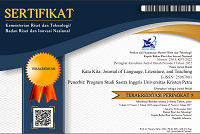Maleficent’s Personality Changes in Maleficent
(1) English Department, Faculty of Humanities and Creative Industries, Petra Christian University
(2) English Department, Faculty of Humanities and Creative Industries, Petra Christian University
(*) Corresponding Author
Abstract
In this study, I analyze Maleficent (2014), the first Disney film to place a previously antagonist character into a protagonist in a new film. In this thesis, I found changes in the personality of Maleficent from good to evil and back to good that caused her to experience anxieties. Therefore, I use Sigmund Freud's psychoanalytic theory of three fundamental elements of the human psyche (id, ego, and superego), anxiety and defense mechanisms. Based on my analysis, I found that Maleficent becomes evil when her id, ego, and superego are unbalanced, and Maleficent can return to being good when her id, ego, and superego are well-balanced. Moreover, Maleficent experiences reality anxiety, neurotic anxiety, and moral anxiety during the process of her personality changes, and she uses defense mechanisms such as aggression, intellectualization, and apathy to overcome her anxieties.
Keywords
Full Text:
PDFReferences
Alwisol. (2010). Psikologi Kepribadian. UMM Press.
Bressler, C. E. (1999). Literary Criticism: An Introduction to Theory and Practice. Prentice
Hall.
Boag, S. (2014). Ego, drives, and the dynamics of internal objects. Frontiers in psychology,
, 666.
Bowin, B. (2004). Psychological Defense Mechanism: A New Study. The American Journal of
Psychoanalysis, 64, 8-10.
Feist, J., & Feist, G. J. (2009). Theories of personality (7th ed.). McGraw Hill.
Freud, S. (1923). The Ego and The Id. W.W. Norton & Company.
Freud, S. (1960). A General Introduction To Psychoanalysis. Washington square press.
Guerin, W. L. (2005). A handbook of critical approaches to literature. New York:
Oxford University Press.
Hall, C. S. (1954). A primer of Freudian psychology. New American Library.
Minderop, A. (2010). Psikologi sastra: karya, metode, teori, dan contoh kasus. Yayasan
Pustaka Obor Indonesia.
Raskin, R. N., & Hall, C. S. (1979). A narcissistic personality inventory. Psychological Reports,
(2), 590.
DOI: https://doi.org/10.9744/katakita.10.2.239-245
Refbacks
- There are currently no refbacks.
Supported by:
Indexed in:
Tools:
Stats (installed since 17 December 2018)
View My Stats













